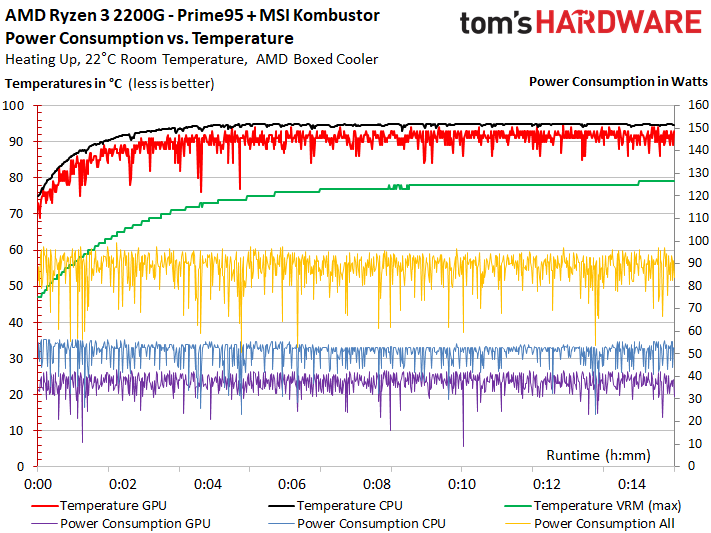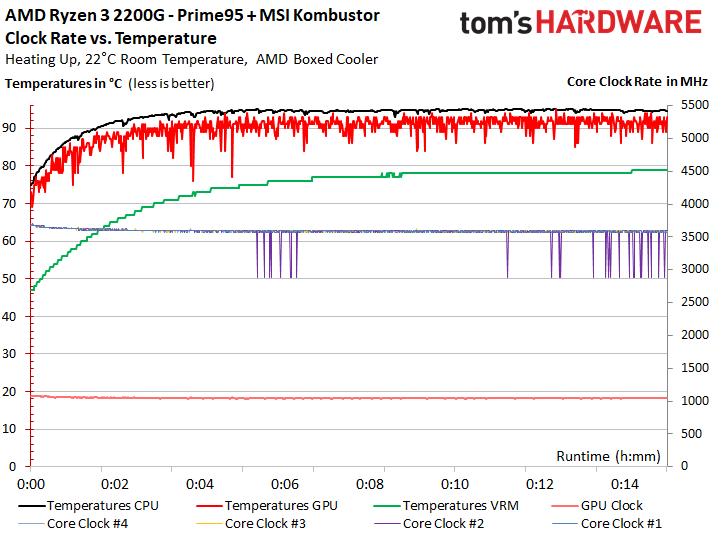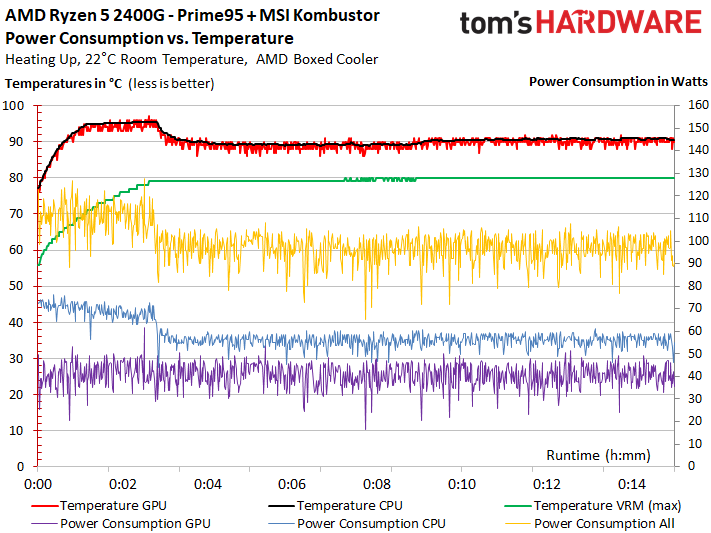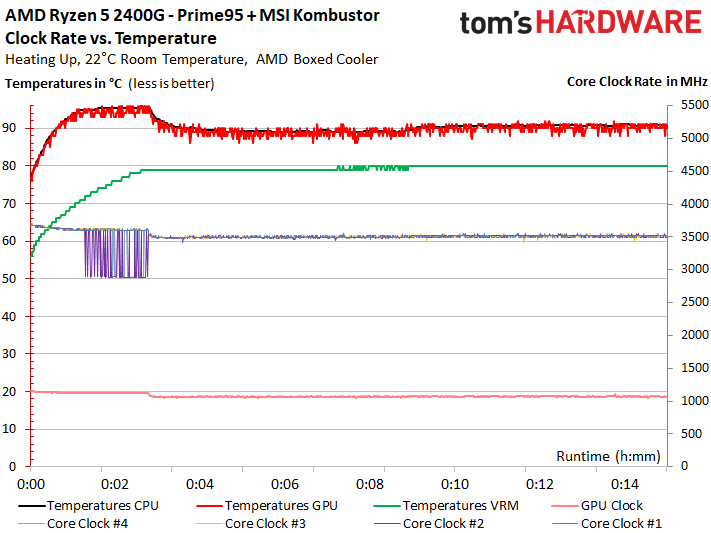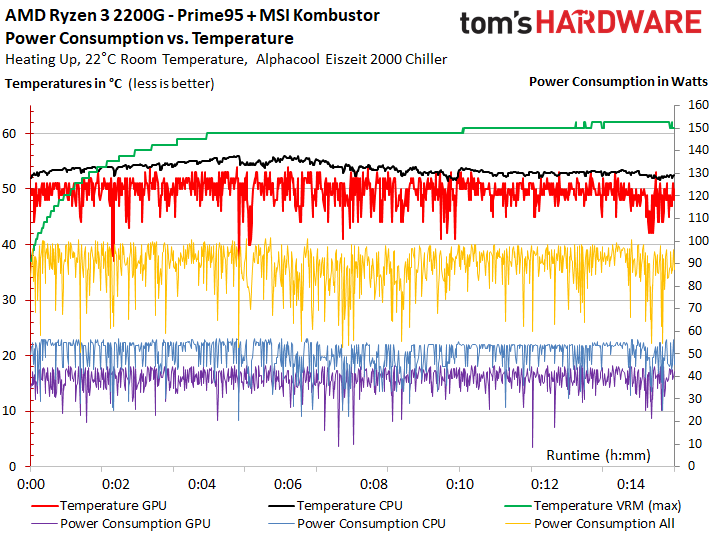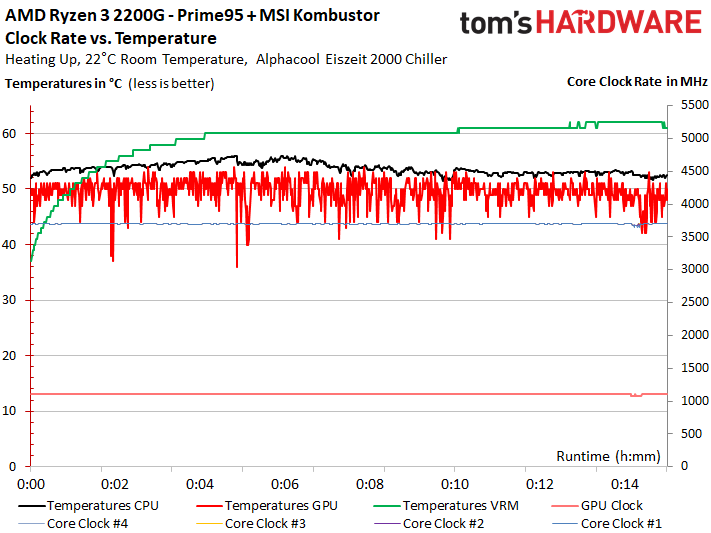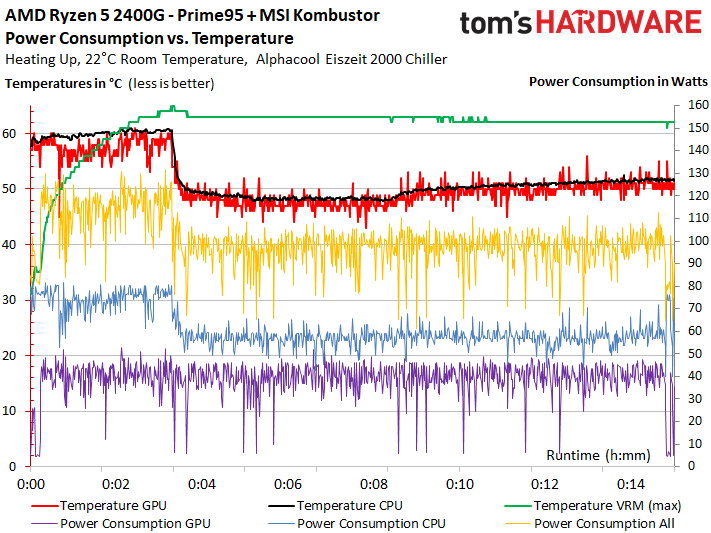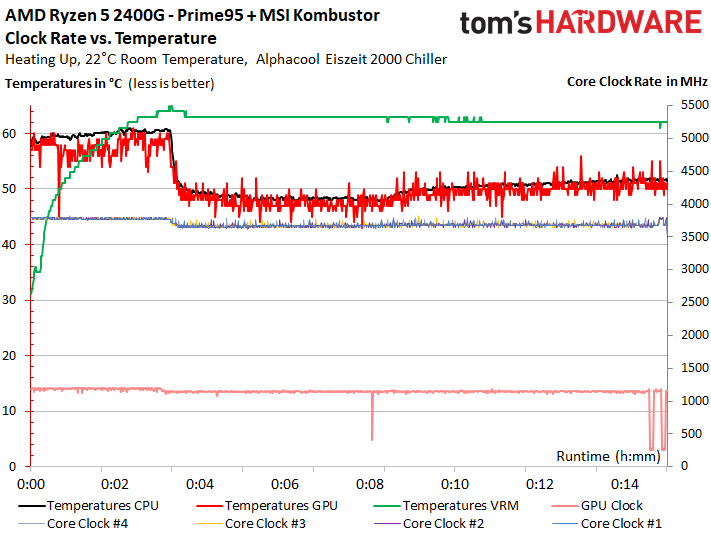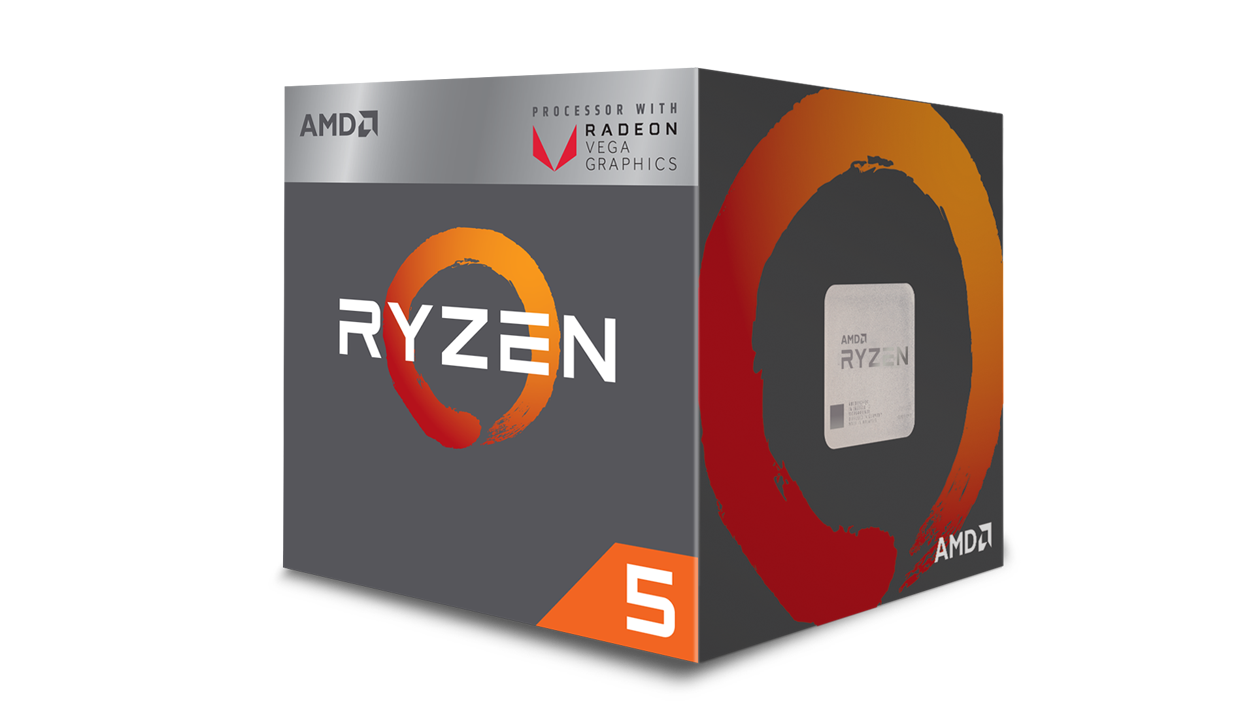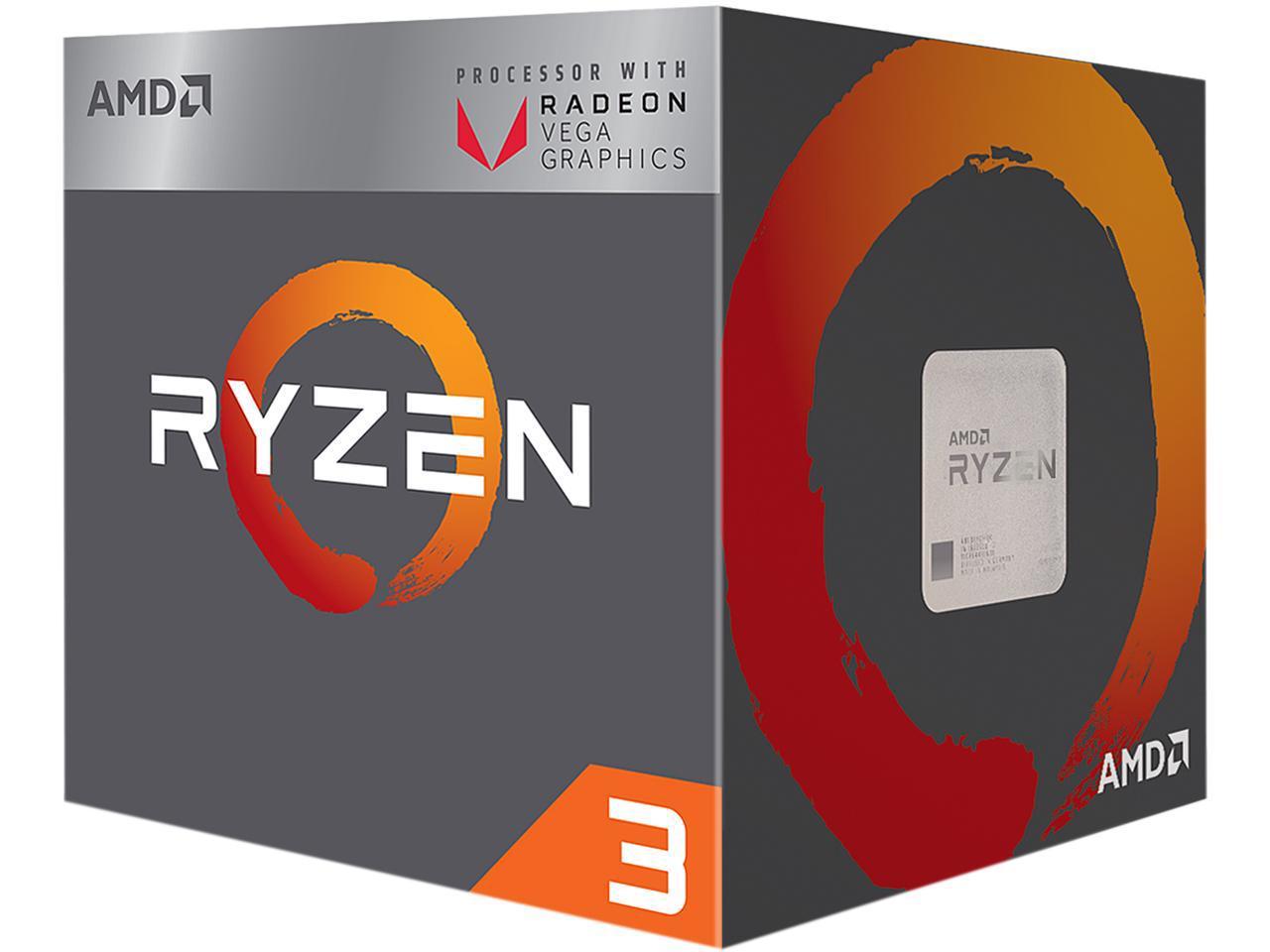AMD Raven Ridge Thermal/Power Analysis: Ryzen CPUs With Vega
Combined Stress Testing: Benchmarks & Results
Extreme Stress Test with the Stock Cooler
The individual CPU and GPU stress tests pushed AMD's stock thermal solution to its limit. So what happens when we tax both sides of Raven Ridge simultaneously? How well are the two blocks balanced, what does maximum power consumption look like, and how much heat is generated?
Once again, this represents an extreme scenario that doesn’t have much to do with either processor's everyday operation. One way or another, though, both chips have to survive the gauntlet.
AMD Ryzen 3 2200G
After ~6 minutes, AMD’s Ryzen 3 2200G hits 95°C. That's well above its thermal limit. And the result doesn't change, even when we push the fan to its fastest rotational speed. With that said, the processor doesn't falter; it keeps going, albeit at an uncomfortably high temperature.
The hottest voltage converters toe the 80°C mark. Average power consumption is close to 88W, while peak power use falls just shy of the 100W threshold.
Plotting frequency over time shows us that the Zen cores slow down slightly once the processor exceeds 94.5W. However, Ryzen does balance this demanding workload well; the missing 100 MHz toward the end of our test is no big deal, particularly since Radeon Vega Graphics isn't affected at all.
In the end, AMD's stock cooler passes our test in a photo finish, with the Zen cores dialing back just a touch.
Get Tom's Hardware's best news and in-depth reviews, straight to your inbox.
AMD Ryzen 5 2400G
The higher-end Ryzen 5 2400G enjoys greater utilization via simultaneous multi-threading and features more Stream processors. Surely it'll hit a wall when we push it hard, right? An average power consumption measurement of ~99W over 15 minutes and peaks close to 128W just can't be dealt with using a small aluminum sink.
Sure enough, after about three minutes, the CPU starts throttling to protect itself. After that, temperatures peak around 92°C, and the voltage converters run at 80°C.
Our corresponding frequency curve shows the throttling kick in even more clearly. The controller tries to maintain balance by frantically bumping clock rates up and back down. After two minutes of failing to rein in thermals, the temperature hits 95°C and AMD's Ryzen 5 2400G pulls the emergency brake. A small frequency dip affects the CPU and GPU, bringing voltage and current down a bit.
After the processor frantically changes the CPU’s frequency (near its thermal limit), it can achieve the original higher clock rate again after a short cooling-off period without a load. However, as soon as the graphics engine throttles, it takes a reboot to recover full functionality. Even a prolonged idle period doesn't help. AMD couldn't (or wouldn't) explain the cause of this behavior.
Extreme Stress Test with the Chiller
Enough of that diminutive stock heat sink and fan. We’re switching to our chiller and a good CPU water block to eliminate thermal bottlenecks. Even under full load, the liquid stays at a constant 20°C, while the air-conditioned room provides 22°C to the blower running at full-blast.
AMD Ryzen 3 2200G
Cooling the Ryzen 3 2200G wasn't a challenge for our massive thermal solution. Consequently, we never had an issue with heat. Average power consumption through our 15-minute run was ~90W, with peaks approaching ~101W. In spite of this, the processor's temperature never exceeded 57°C, and the voltage converters peaked at ~62°C.
The CPU and GPU frequencies remain stable. This means it's possible to circumvent AMD's throttling mechanism on the lower-end 2200G, even under brutal loads, by using an ample cooler. You just need something better than the Wraith Stealth.
AMD Ryzen 5 2400G
But what's this? Ryzen 5 2400G shows us that the chip's throttling behaviors can't be attributable to thermal limits. CPU and GPU temperatures in the 60°C range don't require corrective action by the processor's telemetry. And yet, we again see Ryzen 5 pull its emergency chute, dropping average power consumption from just over 114W (with up to 131W peaks) to ~100W. The voltage converters were at a mere 64°C before the processor started throttling.
Clock rates plotted over time illustrate the drop as well, though they're not as pronounced as our thermal readings. Both the CPU and GPU lose ~100 MHz. And again, it takes a reboot for Ryzen 5 2400G’s frequencies to hit their ceilings once this behavior starts. Simply giving the chip a break to cool off doesn't restore full functionality.
MORE: Best CPUs
MORE: Intel & AMD Processor Hierarchy
MORE: All CPUs Content
Current page: Combined Stress Testing: Benchmarks & Results
Prev Page CPU & GPU Stress Testing: Benchmarks & Results Next Page Power Consumption & Noise
Igor Wallossek wrote a wide variety of hardware articles for Tom's Hardware, with a strong focus on technical analysis and in-depth reviews. His contributions have spanned a broad spectrum of PC components, including GPUs, CPUs, workstations, and PC builds. His insightful articles provide readers with detailed knowledge to make informed decisions in the ever-evolving tech landscape
-
Combat_Medic The prices you chose to use here are bogus - the $99 and $169 MSRP are what they're actually going for.Reply -
AgentLozen ReplyCombat_Medic said:The prices you chose to use here are bogus - the $99 and $169 MSRP are what they're actually going for.
The prices from Amazon or NewEgg (or whatever) are usually inaccurate. I think Tom's should provide us with the MSRP and the internet price. That way, if the internet price is malfunctioning and showing a +50% markup, at least we know what it's SUPPOSED to sell for.
edit: minor fix -
FormatC When I wrote this review, we had only the official MSRP from AMD. The availability in Germany looks ok and the prices in EUR with VAT are lower :)Reply -
Ninjawithagun The prices (provided via direct link to Amazon.com) are now correct. Unfortunately, they are all sold out...lol.Reply -
JamesSneed These seem to be very efficient for the CPU and GPU performance they deliver. Nifty more options for budget PC's.Reply
I am left wondering if the 14nm process AMD is using, is having issues scaling to higher frequencies as it appears you keep Zen and Vega at lower clocks and they are very efficient. -
FormatC I really like the new power management and it is finally nothing else as efficiency-orientated mobile technology for the desktop.Reply -
nuclearpowerofattorney Maybe the 2400G is so smart and powerful, that when it reaches critical computational capacity, it evolves to become sentient, and thus unruly. Only after it is rebooted, to have the sentience removed, will the system cease its rebellious behavior. (Actually, I don't think this..but it's all I've got).Reply -
Rookie_MIB For the 2400G, bundling the better Wraith Spire could probably avoid the throttling bouncing around by preventing it from hitting the thermal limits under the more taxing loads.Reply
Eventually though they're going to have to find out what's causing it to get stuck in that loop. -
7angrytangerines Obviously 2400G wants to protect itself from some poor saps trying to use it for cryptocurrency mining.Reply
